4-Ingredient Fluffy Vegan Protein Pancakes
on Oct 19, 2014, Updated Jul 24, 2024
This post may contain affiliate links.
These thick and fluffy vegan protein pancakes are easy to make in minutes with just 4 basic ingredients.
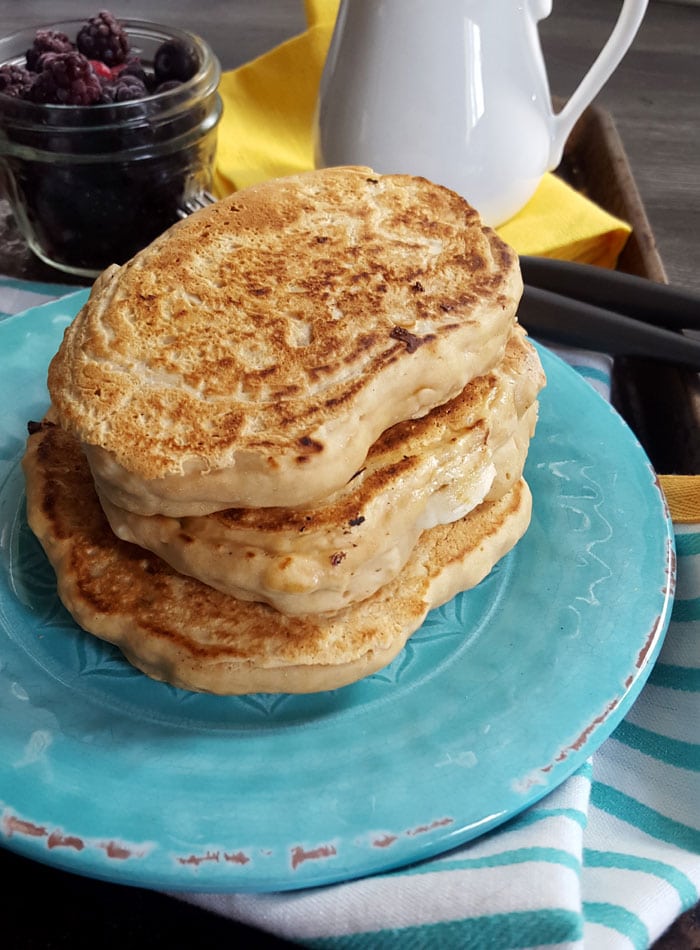
Introduction
Looking for the best protein pancake recipe? This is it! All you need to make them is flour, protein powder, sweetener and baking powder and you’re ready to go.
This super thick pancakes are perfect for a pre or post-workout meal and they’re great for a snack on-the-go too.
They’re quick and easy to make for a weekday breakfast the whole family will enjoy, especially when topped with fruit like berries and banana.
These fluffy whole wheat pancakes, chia seed pancakes, chickpea flour pancakes and buckwheat pancakes are all popular too.
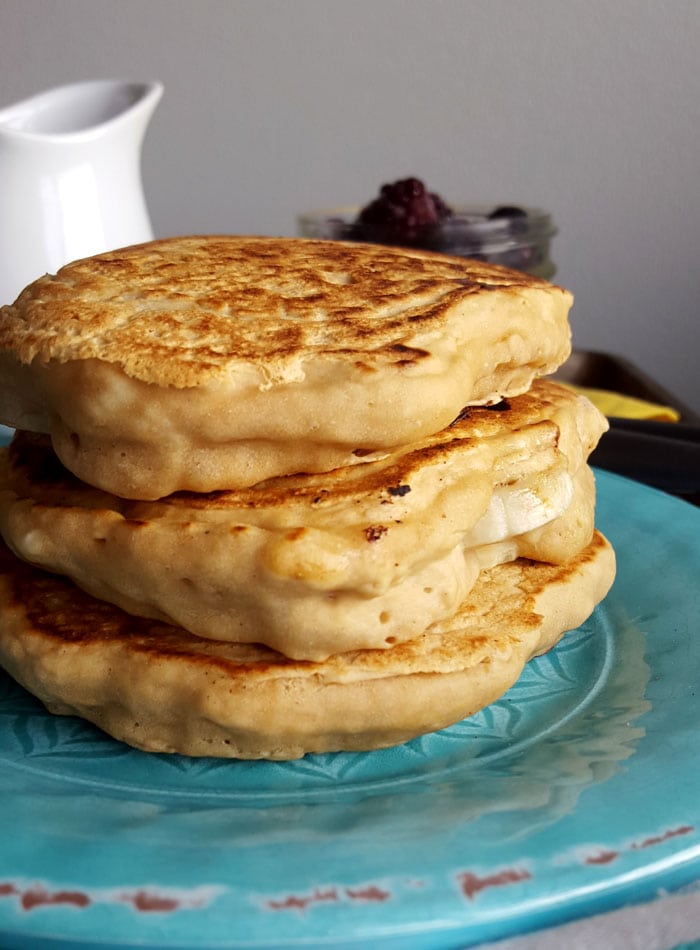
Ingredient Notes
- All-Purpose Flour: The recipe calls for all-purpose flour and that works best for a thick and fluffy result, however, you can also use an all-purpose gluten-free flour, whole wheat flour or white whole wheat flour.
- Vegan Protein Powder: Any variety works. I like Vega, NuZest, Sprout Living, PVL, Outcast Mission and North Coast Naturals.
- Baking Powder: For super thick pancakes, yes, it’s 1 tablespoon, not 1 teaspoon. You can reduce this by up to half and use a reduced-sodium baking powder is sodium content is a concern.
- Sweetener: You may or may not need sweetened depending on the protein powder used. You can use sugar, stevia, monk fruit, coconut sugar, maple syrup, agave syrup, any sweetener you like.
- Liquid: These are made with water and that works just fine though you can use half water and half plant-based milk, if you like.
Add-Ins: Mix up to 1/2 cup fresh berries, chopped fruit or chocolate chips into the batter or add a few piece to each pancake after adding the batter to the pan.
If you’d like to use additional flavourings, you can try 1/2 tsp cinnamon and 1 tsp vanilla extract.
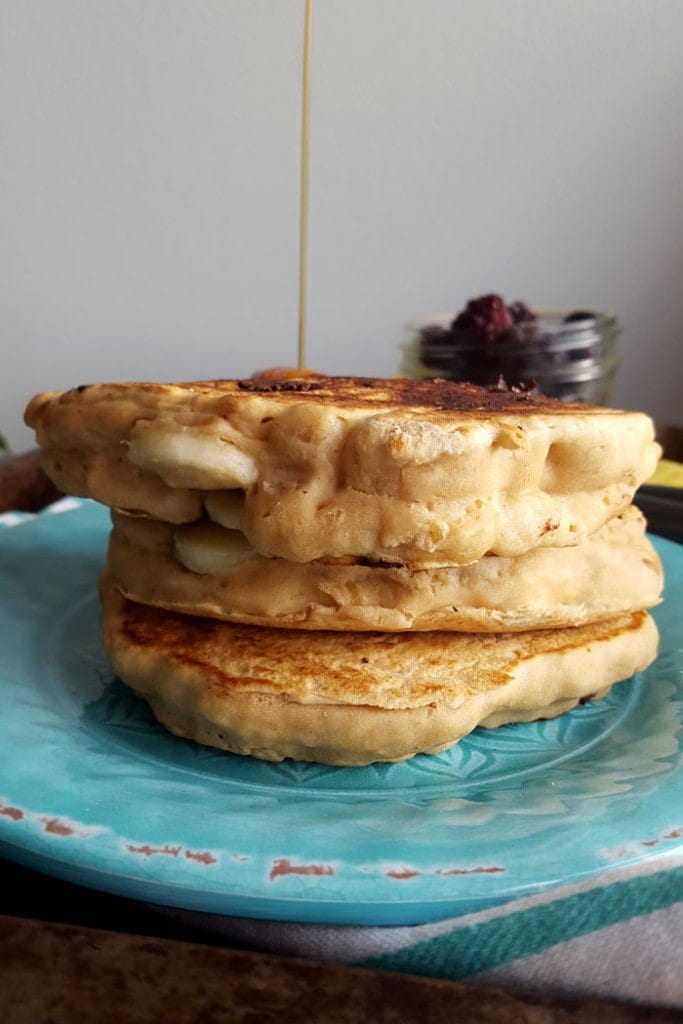
Step-by-Step Instructions
Step 1: Add the flour, protein powder, baking powder and salt (if using a dry sweetener, add that now as well) to a mixing bowl and mix until fully combined with no clumps remaining.
A whisk or fork can help to break up any clumps of flour or protein. This step is important to make sure the baking powder is well distributed.
Step 2: Add the maple syrup, if using, and slowly add the water then mix until all of the flour has been wetted. Once combined, stop mixing.
The batter should be a little lumpy and quite thick but still pourable. Add a little extra water if needed to adjust the consistency. Let the batter rest for 5-10 minutes while you heat a pan over medium-low heat.
Step 3: Add a little oil or cooking spray to your pan if needed then scoop 1/4 cup portions of batter into the pan.
Cook until bubbles appear in the batter and the edges of the pancakes look dry and firm. Flip them and cook fr 102 more minutes.
Enjoy your pancakes with your favourite toppings!
Notes & Tips
Sweetening Options
You may or may not need sweetener depending on the protein powder you use. If you’re using unflavoured protein, try 1-2 tbsp maple syrup, agave syrup, cane sugar or coconut sugar to sweeten your pancakes.
For sugar-free pancakes, you can use stevia powder, liquid stevia or monk fruit sweetened. If you’re using flavoured protein powder such as vanilla, you can reduce or omit the sweetener.
Just give the batter a little taste and see if it’s sweet enough for you then adjust to taste.
Liquid
The original protein pancake recipe called for 1.5 cups water but some readers reported the batter being too running.
The recipe has been adjusted to 1 cup but you may need up to 1.5 cups depending on the protein powder you use, as some absorb more moisture than others.
The recipe works well with 1 cup of liquid, though it results in a very thick pancake. If you want the batter to stretch a little further and make more pancakes, add a little extra water to adjust the consistency. It should be thick but still pourable.
Serving Size
The recipe makes 2 servings, however, the exact number of pancakes it makes will depend on what size you make your pancakes and how much liquid you add.
Regardless of how many pancakes you make, half of the recipe is meant to be one serving as far as the nutrition facts go. Adjust to suit your nutritional needs!
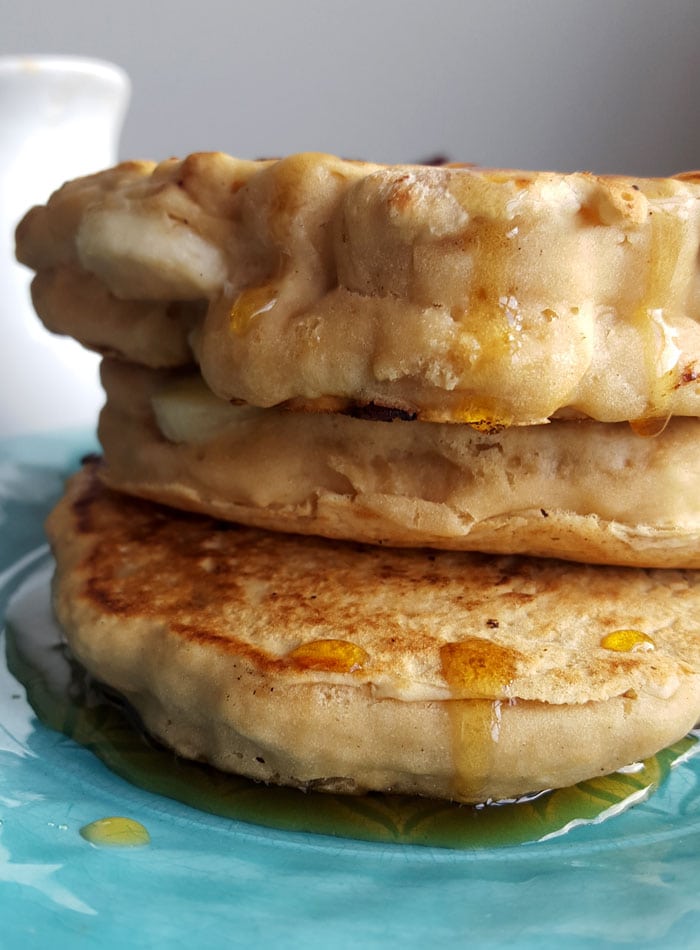
FAQs
Yes. To make these gluten-free, substitute the all-purpose flour with a 1:1 gluten-free flour such as Bob’s Red Mill.
For other high-protein gluten-free pancakes, try my chickpea flour pancakes, buckwheat pancakes or quinoa flour pancakes.
Yes. Whole wheat or white whole wheat flour both work in this recipe.
Yes. To freeze them, let them cool then either freeze them on a baking tray before transferring to a container or bag, or freeze them with pieces of parchment paper between each pancake to prevent sticking.
They’ll keep for up to 3 months in a freezer bag or sealed container and can be reheated in the oven, a pan or if thawed, in the toaster.
Protein pancakes can be a part of a healthy, balanced lifestyle. To increase the nutrition in these pancakes, consider using whole wheat flour, adding 1 tbsp ground flax and topping berries for more fiber and micronutrients to help keep you full throughout the morning.
Adding more protein to your diet can help you feel full, maintain and build lean muscle mass and manage blood sugar levels. That being said, pancakes aren’t a particular great source of protein but adding some protein powder helps.
If you enjoy eating protein pancakes, they can certainly be included in a healthy diet though weight loss is determined by energy balance or the difference between energy (calories) expended and calories consumed.
Protein pancakes won’t do anything in particular to help you lose weight.
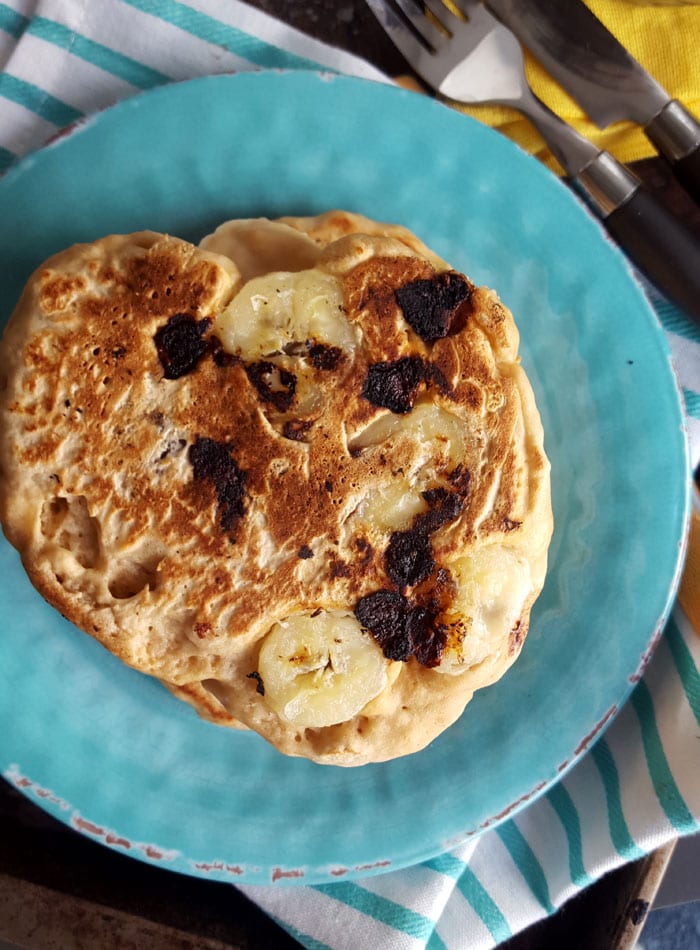
Topping Ideas
Pancake toppings are the best part, aren’t they!? Here are some of my favourites.
- peanut butter, almond butter, tahini or sunflower seed butter
- date paste or dates soaked in hot water then blended to make caramel sauce
- sliced banana
- fresh blueberries, strawberries or cherries
- homemade raw chocolate sauce made from maple syrup, coconut oil and cacao powder
- cacao nibs or dairy-free chocolate chips (you can also add these to the batter for chocolate chip pancakes!)
- maple syrup
- chia seed jam
- coconut butter
- homemade caramel sauce
- shredded coconut
- apple butter
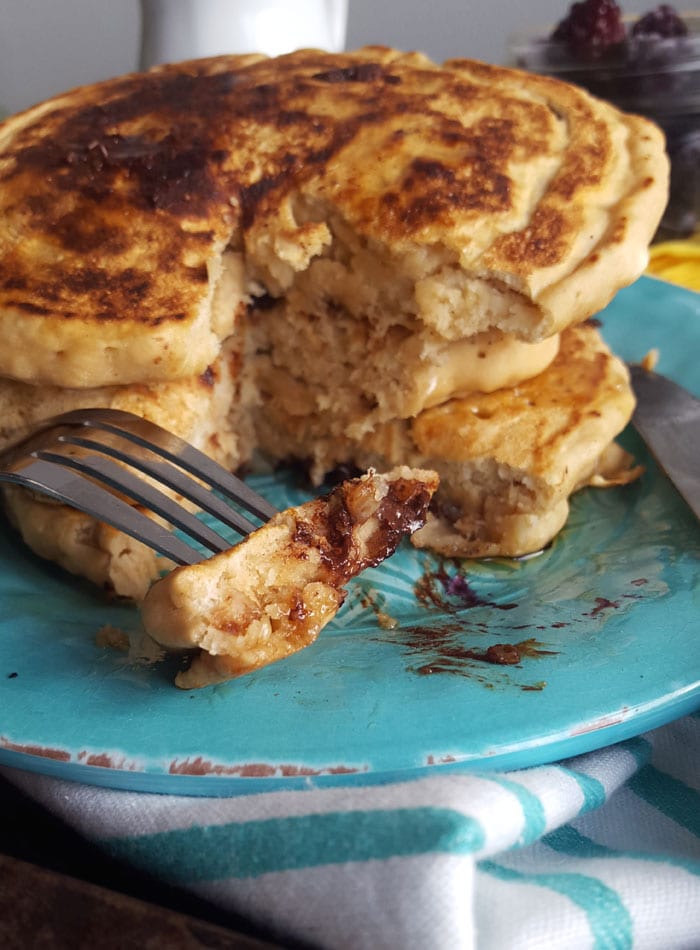
Making Ahead & Storing
- Fridge: Extra pancakes can be stored in a container in the fridge and reheated in the microwave, oven, toaster or in a pan.
- Freezer: Let cool then freeze on a baking tray before transferrring to a bag or container or freeze the pancakes with a piece of parchment between them to prevent sticking.
- They can be reheated from frozen in a pan, the oven or the microwave or thawed at room temperature or in the fridge and reheated in the toaster.
- They’re delicious enjoyed cold too!
Did you try this recipe? I’d love to hear about it! Scroll down to the comment section to leave a star rating and review.
⭐️⭐️⭐️⭐️⭐️
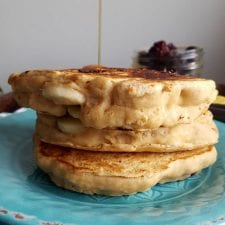
4-Ingredient Fluffy Vegan Protein Pancakes
Ingredients
- 1 cup all-purpose flour, 120 g
- 1/4 cup vegan protein powder of choice, 28 g
- 1 tbsp baking powder
- 1/2 tsp sea salt or kosher salt, see notes
- 2 tbsp maple syrup, see notes
- 1 cup water, plus more as needed, see notes
Instructions
- Mix the flour, protein powder, baking powder (make sure you don’t use baking soda) and salt together in a bowl until well combined, making sure to break up any clumps and fully incorporate the baking powder and salt.
- Add the maple syrup or sweetener of choice if using, then slowly add the water, mixing until “just mixed.” It should be a little lumpy and quite thick but still pourable. Add a little extra water if needed.
- Allow the batter to rest for 5-10 minutes while you heat a pan over medium-low heat. Use a little cooking spray or a good non-stick pan and scoop about 1/4 cup of the batter onto the pan for each pancake.
- Cook until bubbles start to appear and the edges of each pancake look dry and firm. Flip and cook for 1-2 more minutes.
- Enjoy right away with your favorite pancake toppings. Leftovers can be stored in the fridge or freezer and reheated as needed.
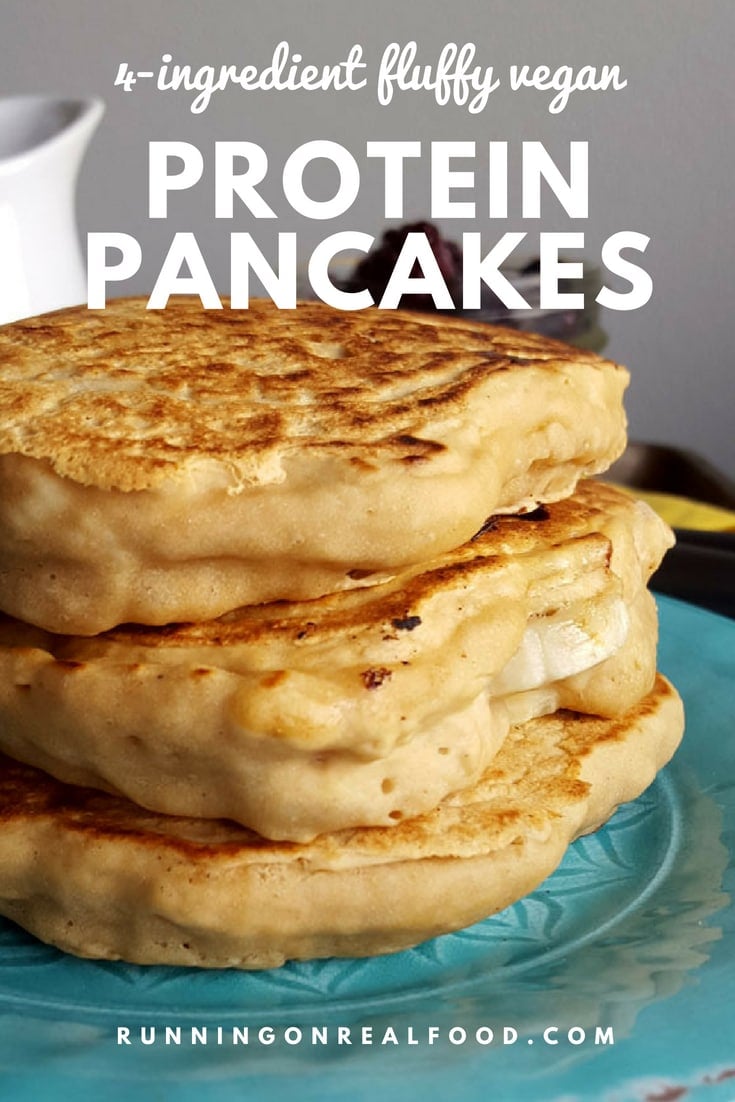
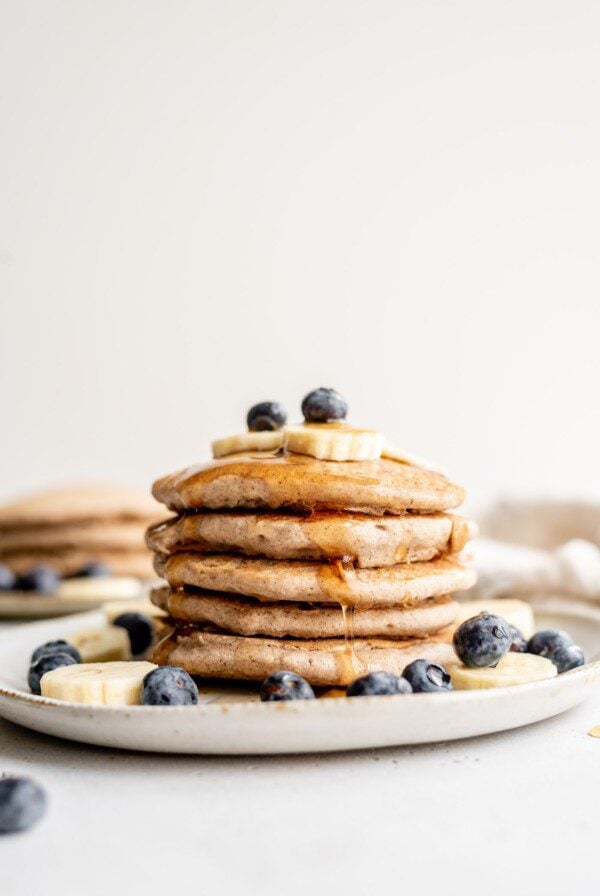
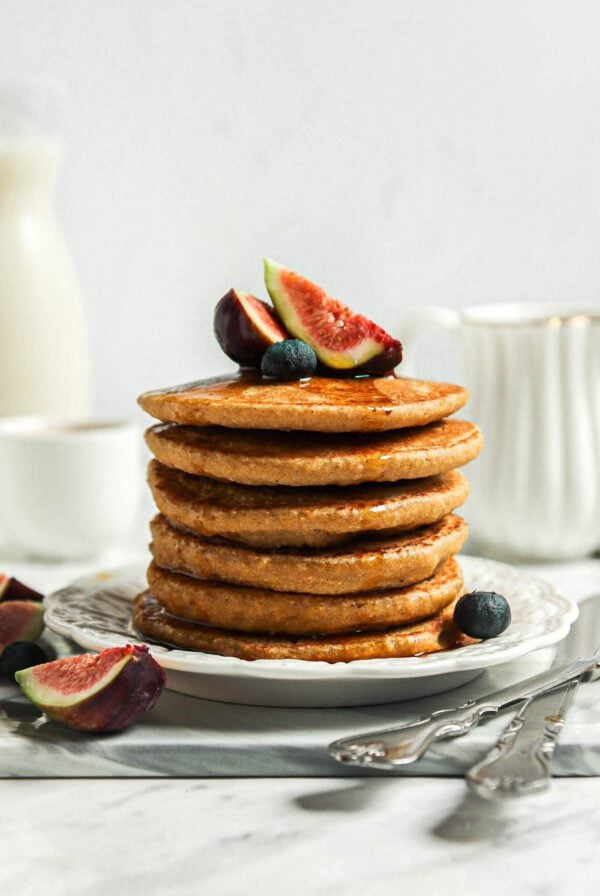
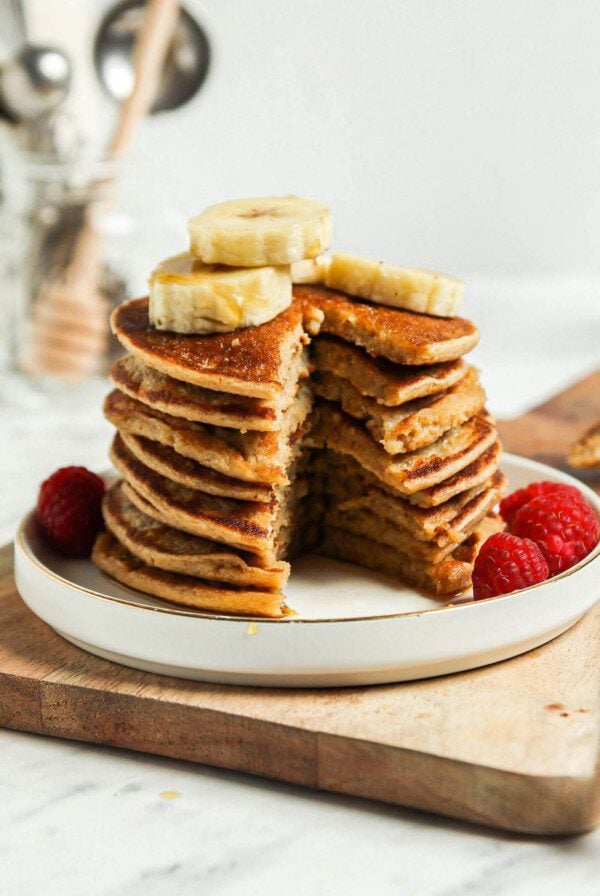
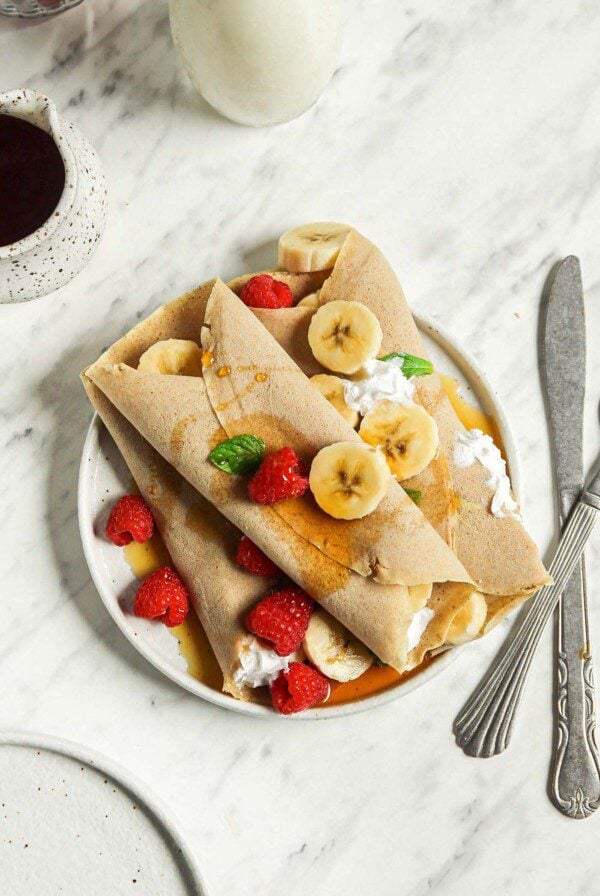








I’ve made these twice so far. The first time I followed the recipe to a tee & it was perfectly delicious. The second time I decided to switch things up & use oat flour & instead of water I used unsweetened soy milk. I mixed the soymilk & maple syrup first & then folded it into the dry ingredients. And I must say it was another hit although my pancakes were green due to the hemp protein powder.
Sounds great! Glad you’re enjoying them.
These were absolutely delicious topped with fruit!!!!
I gave these a chance because I wanted to try pancakes with extra protein (first time doing that), and I’ll be honest, I did not expect them to be great. What a pleasant surprise, they were fantastic! Followed the recipe almost exactly, just had a little more protein powder (neutral flavour pea protein), a little more liquid, and a dash of ground cardamom. The texture was perfect, soft and fluffy. Am defo keeping this recipe and making them regularly! Thanks for the recipe! 🙂
These are the best protein pancakes I have tried……..and I have tried a lot. Lol. I could eat these everday. I cut down the baking powder to 1/2 Tbsp because I don’t like the taste it leaves. And I used 1 cup of water and it was too thick, so I added a 1/4 cup more. The batter was thin…..but they cooked up nice. 🙂 And they taste good, I’m not used to that with all the recipes I ve tried haha…this is the best. Thanks for the recipe.
Thank you so much, Christine! So glad you loved them.
FOR THOSE STRUGGLING TO GET THESE COOKED THROUGH:
I tried this recipe two ways: one with maple syrup, as called for, and once with sugar instead.
With the maple syrup the pancakes were very gummy and not cooked through all the way without burning the outside.
With sugar instead they were very crisp and dry.
I think doing half sugar and half syrup would be ideal, I’ll be trying that next time I make these.
(The flavor was excellent both ways though, even my picky 8year old approved!)
Wow, this was great!!! I tried this morning and they came out perfect! I omitted the sweetener because my protein powder already had some in it (I used chocolate-flavoured protein powder), and I could always pour some maple syrup on top after they were done anyway. For liquid, I had to use a tiny bit more than 1 cup (maybe an additional 1/8 or 1/4 cup). The result was fluffy pancakes, perfectly done and not too sweet (which, to me, it was the right amount). Thanks for this, I’m definitely bookmarking it!
These have been my go to pancakes for a while now! They always turn out so great!
These always seem to turn out gummy for me and don’t cook all the way through. I don’t think I’m over-mixing the batter because I still leave it lumpy…do you have any tips for me? Thanks!! 🙂
Hi! What kind of flour and protein powder are you using? Sorry they’re not turning out for you!
Excellent and truly fluffy!
Glad you liked them, thanks!